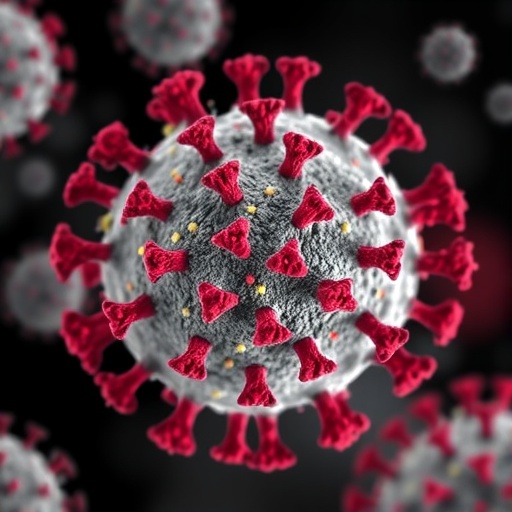Despite the monumental global efforts deployed to counter the COVID-19 pandemic, SARS-CoV-2 remains a persisting threat due to its evolving variants and complex interactions with human cellular machinery. In an insightful breakthrough, scientists at Scripps Research have meticulously charted a comprehensive map of human proteins that the virus co-opts to execute its life cycle, from initial entry into host cells to the eventual release of progeny virions. This expansive identification of host dependency factors offers promising avenues for therapeutic intervention that pivot away from targeting the virus itself to focusing on the human proteins essential for viral propagation.
This pioneering study, published in the renowned journal PLOS Biology on June 12, 2025, harnessed the power of a genome-wide small interfering RNA (siRNA) screening technique. This cutting-edge approach systematically silences individual genes across the human genome in cells naturally permissive to SARS-CoV-2 infection, thus revealing a detailed profile of proteins indispensable for various phases of the viral life cycle. Through this unbiased screen, researchers unveiled a total of 32 proteins required for the virus’s earliest steps of infection, alongside 27 proteins influential during later stages, highlighting a vast network of host factors that SARS-CoV-2 manipulates to subvert cellular processes.
One of the paramount revelations of this work concerns the extracellular matrix protein perlecan. Situated within the supportive meshwork surrounding cells, perlecan is heavily glycosylated, and its sugar chains were found to engage directly with the viral spike protein. This interaction likely facilitates viral attachment and entry, positioning perlecan as a potential co-receptor or critical anchoring site that the virus exploits to initiate infection. Disrupting this binding event could effectively barricade the virus at the cellular doorstep, precluding successful infection and viral spread.
Complementing this discovery, the research identifies Baculoviral IAP Repeat Containing 2 (BIRC2) as another vital human protein co-opted by the virus. BIRC2 operates within the cellular inflammation pathway and was effectively inhibited in both cell culture and murine models through a class of compounds known as second mitochondria-derived activators of caspases (Smac) mimetics. Originally developed to induce apoptosis in oncogenic cells and reactivate latent HIV, these molecules showed unexpected efficacy in lowering SARS-CoV-2 viral loads, opening exciting translational possibilities for repurposing existing drugs.
The significance of host-directed antiviral strategies is underscored by their resilience to viral mutation. Unlike traditional antivirals that target viral proteins—often vulnerable to rapid viral evolution—therapies acting on human proteins present a formidable barrier against resistance. This is exemplified by the team’s validation of identified proteins across multiple coronaviruses, including SARS-CoV-1, MERS-CoV, and a common seasonal coronavirus. Seventeen proteins consistently employed across these viruses emerged, many involved in fundamental viral processes such as membrane fusion, genome replication, and virion egress, emphasizing the potential for pan-coronavirus therapeutic development.
Such a paradigm shift to host-centric antiviral development heralds transformative potential for pandemic preparedness. By preemptively cultivating drugs that disable viral reliance on human cellular pathways, the scientific community may establish a broad-spectrum antiviral arsenal capable of rapid deployment against future emergent coronaviruses, including potential SARS-CoV-3 strains. This strategic foresight bolsters defenses by elevating barriers to resistance, thus mitigating the cyclical emergence of drug-resistant viral forms.
The interdisciplinary collaboration encompassing immunology, virology, molecular biology, and pharmacology integrated an array of model systems and experimental frameworks, ranging from human epithelial cultures to animal infection models. This integrated methodology not only lends robustness to the findings but also strengthens the translational relevance of host protein targeting compounds. The cross-validation of siRNA data with mechanistic assays and viral inhibition studies underscores the rigor of the scientific approach employed by the investigators.
Importantly, the intricate process of viral exploitation of host proteins extends beyond attachment and entry. Several of the identified proteins mediate distinct cellular pathways, including cytoskeletal dynamics, vesicular trafficking, RNA processing, and immune modulation. This multifaceted hijacking underscores the virus’s reliance on diverse host systems to orchestrate replication, assembly, and release. Deciphering these interactions at a molecular level is pivotal for rational drug design and tailoring interventions that disrupt key viral dependencies without impinging on essential cellular functions.
The research team is poised to expand their investigations to explore if other respiratory viruses, such as influenza and respiratory syncytial virus (RSV), similarly leverage these or related host factors. Such findings could broaden the impact of identified targets and advance the development of versatile antiviral agents capable of combating a spectrum of respiratory pathogens. Concurrently, ongoing and future preclinical studies will rigorously evaluate candidate compounds’ safety profiles and antiviral efficacies, steering the translational trajectory towards clinical applicability.
Dr. Sumit Chanda, co-senior author and professor of immunology and microbiology at Scripps Research, emphasizes the strategic value of host-directed therapies in circumventing the challenges posed by viral mutation. He notes that understanding the intricate virus-host interface provides a powerful foundation for developing therapeutics that remain robust in the face of viral evolution and emerging variants. This work not only contributes critical scientific insights but also heralds a new horizon in antiviral drug discovery.
Co-senior author Dr. Laura Martin-Sancho highlights perlecan as a particularly intriguing target, underscoring the importance of glucose chain interactions that mediate viral attachment. Targeting such extracellular matrix components could offer an innovative antiviral strategy that intercepts the virus at the earliest stage of infection. The convergence of molecular virology and glycoscience exemplified here paves the way for novel therapeutic modalities that disrupt viral entry mechanisms.
Overall, this landmark study provides an in-depth atlas of human host factors co-opted by SARS-CoV-2 and related coronaviruses, illuminating vulnerabilities exploitable by next-generation antivirals. By shifting focus from the rapidly mutable viral genome to the more stable host proteins essential for virus propagation, researchers chart a promising course towards durable and broad-spectrum coronavirus therapeutics. The implications for global health resilience and pandemic prevention are profound, as these findings offer new hope in the ongoing fight against current and future viral threats.
Subject of Research: Identification of human host proteins critical for SARS-CoV-2 replication and late stages of infection through genome-wide siRNA screening.
Article Title: Global siRNA screen identifies human host factors critical for SARS-CoV-2 replication and late stages of infection
News Publication Date: June 12, 2025
Web References: https://journals.plos.org/plosbiology/article?id=10.1371/journal.pbio.3002738
Image Credits: Laura Martin-Sancho
Keywords: SARS-CoV-2, coronavirus, human host proteins, perlecan, BIRC2, siRNA screening, antiviral therapies, host-directed antivirals, Smac mimetics, viral replication, viral entry, pan-coronavirus treatment
Tags: breakthroughs in coronavirus researchevolution of coronavirus variantsgenome-wide siRNA screening in viral researchhuman cellular machinery and viruseshuman proteins in COVID-19 replicationmapping human-virus interactionsPLOS Biology journal publicationpromising avenues for COVID-19 therapiesproteins essential for viral propagationSARS-CoV-2 host dependency factorsScripps Research coronavirus studytherapeutic targets for coronavirus treatment





